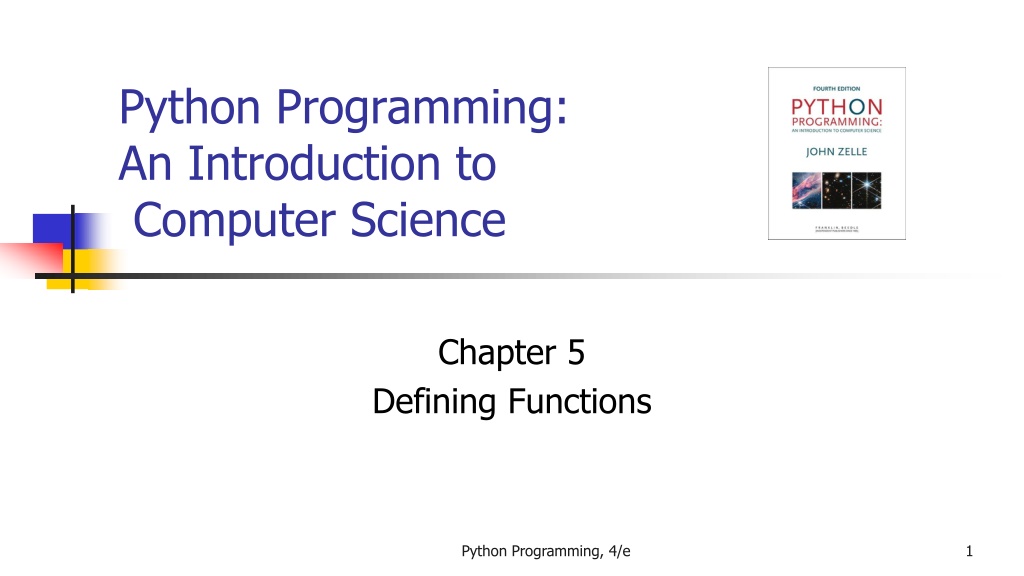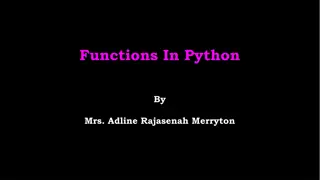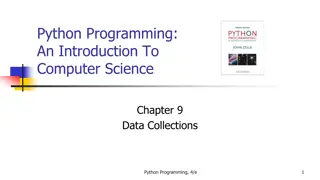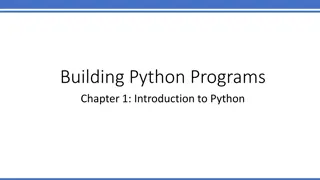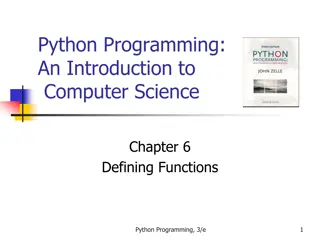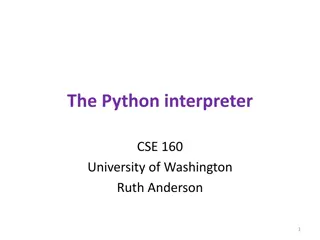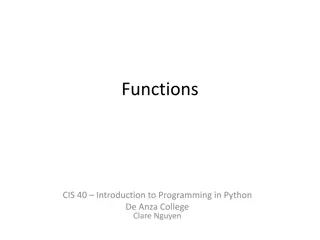Introduction to Defining Functions in Python Programming
This chapter introduces the concept of defining functions in Python programming. It covers the importance of dividing programs into sets of cooperating functions, defining new functions in Python, understanding function calls and parameter passing, and reducing code duplication through the use of functions. Functions are discussed as subprograms that help in organizing code and making programs more modular.
Download Presentation

Please find below an Image/Link to download the presentation.
The content on the website is provided AS IS for your information and personal use only. It may not be sold, licensed, or shared on other websites without obtaining consent from the author. Download presentation by click this link. If you encounter any issues during the download, it is possible that the publisher has removed the file from their server.
E N D
Presentation Transcript
Python Programming: An Introduction to Computer Science Chapter 5 Defining Functions Python Programming, 4/e 1
Objectives To understand why programmers divide programs up into sets of cooperating functions. To be able to define new functions in Python. To understand the details of function calls and parameter passing in Python. Python Programming, 4/e 2
Objectives To write programs that use functions to reduce code duplication and increase program modularity. Python Programming, 4/e 3
The Function of Functions So far, we ve seen four different types of functions: Our programs comprise a single function called main(). Built-in Python functions (print, abs) Functions from the standard libraries (math.sqrt) Functions from the graphics module (p.getX()) Python Programming, 4/e 4
The Function of Functions Having similar or identical code in more than one place has some drawbacks. Issue one: writing the same code twice (or more!). Issue two: This same code must be maintained in two separate places. Functions can be used to reduce code duplication and make programs more easily understood and maintained. Python Programming, 4/e 5
Functions, Informally A function is like a subprogram, a small program inside of a program. The basic idea we write a sequence of statements and then give that sequence a name. We can then execute this sequence at any time by referring to that name. Python Programming, 4/e 6
Functions, Informally The part of the program that creates a function is called a function definition. When the function is used in a program, we say the definition is called or invoked. Python Programming, 4/e 7
Functions, Informally Happy Birthday lyrics def main(): print("Happy birthday to you!" ) print("Happy birthday to you!" ) print("Happy birthday, dear Fred...") print("Happy birthday to you!") Gives us this >>> main() Happy birthday to you! Happy birthday to you! Happy birthday, dear Fred... Happy birthday to you! Python Programming, 4/e 8
Functions, Informally There s some duplicated code in the program! (print("Happy birthday to you!")) We can define a function to print out this line: def happy(): print("Happy birthday to you!") With this function, we can rewrite our program. Python Programming, 4/e 9
Functions, Informally The new program def happy(): print("Happy birthday to you!") Gives us this output >>> singFred() Happy birthday to you! Happy birthday to you! Happy birthday, dear Fred... Happy birthday to you! def singFred(): happy() happy() print("Happy birthday, dear Fred...") happy() Python Programming, 4/e 10
Functions, Informally Creating this function saved us a lot of typing! What if it s Lucy s birthday? We could write a new singLucy function! def singLucy(): happy() happy() print("Happy birthday, dear Lucy...") happy() Python Programming, 4/e 11
Functions, Informally We could write a main program to sing to both Lucy and Fred def main(): singFred() print() singLucy() This gives us this new output >>> main() Happy birthday to you! Happy birthday to you! Happy birthday, dear Fred.. Happy birthday to you! Happy birthday to you! Happy birthday to you! Happy birthday, dear Lucy... Happy birthday to you! Python Programming, 4/e 12
Functions, Informally This is working great! But there s still a lot of code duplication. The only difference between singFred and singLucy is the name in the third print statement. These two routines could be collapsed together by using a parameter. Python Programming, 4/e 13
Functions, Informally The generic function sing def sing(person): happy() happy() print("Happy birthday, dear", person + ".") happy() This function uses a parameter named person. A parameter is a variable that is initialized when the function is called. Python Programming, 4/e 14
Functions, Informally Our new output >>> sing("Fred") Happy birthday to you! Happy birthday to you! Happy birthday, dear Fred. Happy birthday to you! We can put together a new main program! Python Programming, 4/e 15
Functions, Informally Our new main program: def main(): sing("Fred") print() sing("Lucy") Gives us this output: >>> main() Happy birthday to you! Happy birthday to you! Happy birthday, dear Fred. Happy birthday to you! Happy birthday to you! Happy birthday to you! Happy birthday, dear Lucy. Happy birthday to you! Python Programming, 4/e 16
Future Value with a Function In the future value graphing program, we see similar code twice: # Draw bar for initial principal bar = Rectangle(Point(0, 0), Point(1, principal)) bar.setFill("green") bar.setWidth(2) bar.draw(win) bar = Rectangle(Point(year, 0), Point(year+1, principal)) bar.setFill("green") bar.setWidth(2) bar.draw(win) Python Programming, 4/e 17
Future Value with a Function To properly draw the bars, we need three pieces of information. The year the bar is for How tall the bar should be The window the bar will be drawn in These three values can be supplied as parameters to the function. Python Programming, 4/e 18
Future Value with a Function The resulting function looks like this: def drawBar(window, year, height): # Draw a bar in window starting at year with given height bar = Rectangle(Point(year, 0), Point(year+1, height)) bar.setFill("green") bar.setWidth(2) bar.draw(window) To use this function, we supply the three values. If win is a Graphwin, we can draw a bar for year 0 and principal of $2000 using this call: drawBar(win, 0, 2000) Python Programming, 4/e 19
Functions and Parameters: The Details It makes sense to include the year and the principal in the drawBar function, but why send the window variable? The scope of a variable refers to the places in a program a given variable can be referenced. Python Programming, 4/e 20
Functions and Parameters: The Details Each function is its own little subprogram. The variables used inside of a function are local to that function, even if they happen to have the same name as variables that appear inside of another function. The only way for a function to see a variable from another function is for that variable to be passed as a parameter. Python Programming, 4/e 21
Functions and Parameters: The Details Since the GraphWin (the variable win) is created inside of main, it is not directly accessible in drawBar. The window parameter in drawBar gets assigned the value of win from main when drawBar is called. Python Programming, 4/e 22
Functions and Parameters: The Details A function definition looks like this: def <name>(<formal-parameters>): <body> The name of the function must be an identifier Formal-parameters is a (possibly empty) list of variable names Python Programming, 4/e 23
Functions and Parameters: The Details Formal parameters, like all variables used in the function, are only accessible in the body of the function. Variables with identical names elsewhere in the program are distinct from the formal parameters and variables inside of the function body. Python Programming, 4/e 24
Functions and Parameters: The Details A function is called by using its name followed by a list of actual parameters or arguments. <name>(<actual-parameters>) When Python comes to a function call, it initiates a four-step process. Python Programming, 4/e 25
Functions and Parameters: The Details The function calling four-step process The calling program suspends execution at the point of the call. The formal parameters of the function get assigned the values supplied by the actual parameters in the call. The body of the function is executed. Control returns to the point just after where the function was called. Python Programming, 4/e 26
Functions and Parameters: The Details Let s trace through the following code: sing("Fred") print() sing("Lucy") When Python gets to sing("Fred"), execution of main is temporarily suspended. Python looks up the definition of sing and sees that it has one formal parameter, person. Python Programming, 4/e 27
Functions and Parameters: The Detail The formal parameter is assigned the value of the actual parameter. It s as if the following statement had been executed: person = "Fred" Python Programming, 4/e 28
Functions and Parameters: The Details Note that the variable person has just been initialized. Python Programming, 4/e 29
Functions and Parameters: The Details At this point, Python begins executing the body of sing. The first statement is another function call, to happy. What happens next? Python suspends the execution of sing and transfers control to happy. happy consists of a single print, which is executed and control returns to where it left off in sing. Python Programming, 4/e 30
Functions and Parameters: The Details Execution continues in this way with two more trips to happy. When Python gets to the end of sing, control returns to main and continues immediately following the function call. Python Programming, 4/e 31
Functions and Parameters: The Details Notice that the person variable in sing has disappeared! The memory occupied by local function variables is reclaimed when the function exits. Local variables do not retain any values from one function execution to the next. Python Programming, 4/e 32
Functions and Parameters: The Details The next statement is the bare print, which produces a blank line. Python encounters another call to sing, and control transfers to the sing function, with the formal parameter Lucy . Python Programming, 4/e 33
Functions and Parameters: The Details The body of sing is executed for Lucy with its three side trips to happy and control returns to main. Python Programming, 4/e 34
Functions and Parameters: The Details Python Programming, 4/e 35
Functions and Paramters: The Details One thing not addressed in this example was multiple parameters. In this case the formal and actual parameters are matched up based on position, e.g. the first actual parameter is assigned to the first formal parameter, the second actual parameter is assigned to the second formal parameter, etc. Python Programming, 4/e 36
Functions and Parameters: The Details As an example, consider the call to drawBar: drawBar(win, 0, principal) When control is passed to drawBar, these parameters are matched up to the formal parameters in the function heading: def drawBar(window, year, height): Python Programming, 4/e 37
Functions and Parameters: The Details The net effect is as if the function body had been prefaced with three assignment statements: Given drawbar(win, 0, principal) and def drawbar(window, year, height) window = win year = 0 height = principal Python Programming, 4/e 38
Functions That Return Values Passing parameters provides a mechanism for initializing the variables in a function. Parameters act as inputs to a function. We can call a function many times and get different results by changing its parameters. Python Programming, 4/e 39
Functions That Return Values We ve already seen numerous examples of functions that return values to the caller. discRt = math.sqrt(b*b 4*a*c) The value b*b 4*a*c is the actual parameter of math.sqrt. We say sqrt returns the square root of its argument. Python Programming, 4/e 40
Functions That Return Values This function returns the square of a number: def square(x): return x*x When Python encounters return, it exits the function and returns control to the point where the function was called. In addition, the value(s) provided in the return statement are sent back to the caller as an expression result. Python Programming, 4/e 41
Functions That Return Values >>> square(3) 9 >>> print(square(4)) 16 >>> x = 5 >>> y = square(x) >>> print(y) 25 >>> print(square(x) + square(3)) 34 Python Programming, 4/e 42
Functions That Return Values We can use the square function to write a routine to calculate the distance between (x1,y1) and (x2,y2). def distance(p1, p2): dist = math.sqrt(square(p2.getX() - p1.getX()) + square(p2.getY() - p1.getY())) return dist Python Programming, 4/e 43
Functions That Return Values The order of the function definitions in the program is not important. We just have to make sure a function is defined before the program actually tries to run it. Since our call to main does not usually happen until the every last line of the module, all of the functions will be defined before the program starts running. Python Programming, 4/e 44
Functions That Return Values Through the magic of value-returning functions, we can streamline our program to a single string expression: lyrics = (happy() + happy() + "Happy birthday, dear " + person + ".\n" + happy()) The right hand side is parenthesized so it can span several lines. This makes use of string concatenation (+) This demonstrates the power of value-returning functions. Python Programming, 4/e 45
Functions That Return Values Sometimes a function needs to return more than one value. To do this, simply list more than one expression in the return statement. def sumDiff(x, y): plus = x + y minus = x y return plus, minus Python Programming, 4/e 46
Functions That Return Values When calling this function, use simultaneous assignment. s, d = sumDiff(num1, num2) print("The sum is", s, "and the difference is", d) As before, the values are assigned based on position, so s gets the first value returned (the sum), and d gets the second (the difference). Python Programming, 4/e 47
Functions That Return Values One gotcha all Python functions return a value, whether they contain a return statement or not. Functions without a return hand back a special object, denoted None. A common problem is writing a value-returning function and forgetting the return! Python Programming, 4/e 48
Functions That Return Values If your value-returning functions produce strange messages, check to make sure you remembered to include the return! def distance(p1, p2): dist = math.sqrt(square(p2.getX() - p1.getX()) + square(p2.getY() - p1.getY())) perim = distance(p1, p2) + distance(p2, p3) + distance(p3, p1) Traceback (most recent call last): File "<pyshell#24>", line 1, in <module> perim = distance(p1, p2) + distance(p2, p3) + distance(p3, p1) TypeError: unsupported operand type(s) for +: 'NoneType' and 'NoneType' Python Programming, 4/e 49
Functions that Modify Parameters Return values are the main way to send information from a function back to the caller. Sometimes, we can communicate back to the caller by making changes to the function parameters. Understanding when and how this is possible requires the mastery of some subtle details about how assignment works and the relationship between actual and formal parameters. Python Programming, 4/e 50
